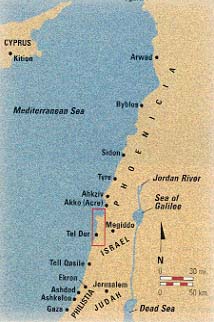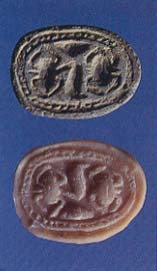The Many Masters of Dor, Part 1: When Canaanites Became Phoenician Sailors
022

History runs deep at Tel Dor—45 feet deep to be exact! Layer upon layer of ancient cities, each built on the ruins of its predecessor, have formed this immense mound on Israel’s Mediterranean coast, about 12 miles south of Haifa. As extraordinary as the mound’s size is the large number of different people who have occupied or controlled the site. Following the Canaanites, who led Dor in a coalition of cities opposing Joshua (Joshua 11:1–15), the city experienced a series of conquests by Sikils—a Sea People tribe—Phoenicians, Israelites, Assyrians, Babylonians, and Persians. Despite this succession of conquests, the Phoenicians remained the dominant cultural force at Dor, which preserves one of the best records of their culture yet found.
In this first installment of a three-part article, Ephraim Stern, director of the Dor excavation, describes the city’s rise, its conquest by the Sikils and its reconquest by the Phoenicians. “The Many Masters of Dor, Part 2: How Bad Was Ahab?” BAR 19:02, will examine the Phoenician-Israelite city at Dor until its fall to the Assyrians in 733 B.C.E. “The Many Masters of Dor, Part 3: The Persistence of Phoenician Culture,” BAR 19:03, will look at the succession of absentee landlords—Assyrian, Babylonian and Persian—who ruled Dor until the city’s complete Hellenization in the third century B.C.E.
024
If you want to learn about the Phoenicians, come to Dor.1 But Dor, you may say, was not part of Phoenicia proper. True enough. Thereby hangs my tale.
Actually, the Phoenicians were late Canaanites—Canaanites of the first millennium B.C.E.a “Phoenician” was the name given to these people by the Greeks. The name apparently denotes the dark red or purple dye for which the Phoenicians were famous. The Phoenicians, however, continued to refer to themselves as Canaanites, or by the names of their principal cities—Sidonians, Tyrians, Biblians, Arwadians.
During the second millennium B.C.E., the Canaanites controlled not only Palestine, but Transjordan and Syria as well, all the way from Ugarit in the north down to the Egyptian border in the south. Beginning in about 1200 B.C.E., they were squeezed out of most of this area by numerous peoples of various origins: Arameans penetrated from the northeast, Hittites from the northwest, Israelites and Sea Peoples (Philistines, Sikils, Sherden, etc.) in the south and Ammonites, Moabites and Edomites in the east. By about 1150 B.C.E., Canaanite territory was reduced to the narrow coastal strip of Lebanon between Arwad and Tyre. Most of the Canaanite population lived in four main cities—Arwad, Byblos, Sidon and Tyre. From this point on, historians refer to this area as Phoenicia and to the people as Phoenicians.
If contraction characterized the 150-year period beginning about 1200 B.C.E., expansion characterized Phoenician history beginning about 1050 B.C.E.—not so much by conquest, however, as by colonization and cultural influence. This is what we are learning largely from archaeological evidence uncovered in recent decades. The direction of Phoenician expansion was, for the most, part, westward: The Phoenicians became sailors, some of the most renowned in the world. First they reached Cyprus; then they journeyed on to the coasts of Sicily, Sardinia and Malta, subsequently to southern Spain and, particularly important, to northern Africa, thereby creating a vast commercial empire with its capital at Carthage. The Phoenician colonists in the western Mediterranean were later described by the Romans as “Punic”; in the three Punic Wars, Rome attacked and defeated Carthage, ending Punic domination of the western Mediterranean, including Sicily, Sardinia and the Punic province in Spain. In the last of the Punic Wars, Carthage itself was, as Cato had so often demanded, destroyed.
Carthage was destroyed in 152 B.C.E. The Phoenician empire had lasted almost a millennium.
Tel Dor, where we have been digging for 12 seasons, is located on the eastern Mediterranean coast about 12 miles south of the Carmel spur and the modern Israeli city of Haifa. The rectangular tell itself lies on the seashore, enclosed by natural bays on the north and south. A third, smaller bay washes into the center of the western side of the tell. According to Israeli marine archaeologist Avner Raban, who has studied the coastline of the mound, a lagoon originally existed on the eastern side of the mound, so that the tell was almost completely surrounded by water, with the exception of a narrow passageway to the east. In the course of time, however, this lagoon was blocked with silt. Today the mound extends into the sea on three sides.
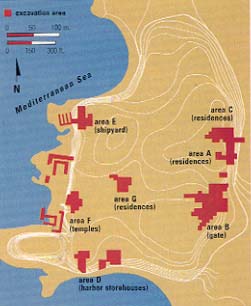
Nearly flat on top at present, Tel Dor rises over 45 feet above sea level. Most of this is artificial accumulation. In other words, to get to the earliest stratum, we will have to dig, in places, as much as 45 feet below the surface!
In antiquity, the tell apparently extended farther west, but from time to time the sea level has risen and the western side of the mound has washed away. In this way about 15 percent of the tell has disappeared.
Although Dor is mentioned in the Bible, the earliest reference to the city appears in an inscription of Pharaoh Ramesses II (13th century B.C.E.) that contains a list of settlements along the Via Maris, including its western branch running from the Sharon plain to the Acre plain. The archaeological finds, however, indicate that Dor was founded as early as the 20th century B.C.E. (Middle Bronze Age IIA). This was the Canaanite city that occupied the site for nearly a thousand years—until about 1200 B.C.E. Until about this time the Canaanites dominated the entire region—Palestine, Phoenicia, Syria and Transjordan. Canaanite material culture, well known from scores of excavations throughout the region, is exceedingly rich and varied. This was especially true during the Late Bronze Age (1500–1200 B.C.E.), after the Egyptian conquest of Palestine, when far-flung international trade and Egyptian domination had a strong influence on local culture. The most prosperous representatives of this culture seem to have been concentrated in the coastal cities and their immediate hinterland, cities like Ugarit, Byblos, Megiddo—and Dor. One day we will find more evidence of Canaanite Dor; however, because of the great depth of these remains, the present 025excavations have not yet reached the strata in which they lie. Even after 12 excavation seasons, we have little information about the Canaanite city, except in a few spots near the sea that helped us establish the existence of the city at such an early date. The finds from these levels include not only much Middle and Late Bronze pottery, but also some Egyptian seals. More than 50 percent of the pottery was imported, mostly from the west—Minoan, Mycenaean and Cypriot ware.
The next culture to make its appearance at Dor—in about 1200 B.C.E.—is that of the Sikils, one of the Sea Peoples, a collection of tribes of which the best known is the Philistines, who settled on the Mediterranean coast south of the Sikils. The Sikil culture at Dor provides a kind of 150-year interlude between the Canaanites and their Phoenician descendants.
Unlike the research on their brothers the Philistines, about whom we know a great deal, research on the Sikils is in its infancy. According to Egyptian literary sources, the Sea Peoples who attacked Palestine and Egypt at the beginning of the 12th century B.C.E. included several tribes: Philistines, Sikils, Sherden, Shekelesh, Denyen and Weshesh. Three or perhaps four of these tribes settled in Palestine: Philistines, Sikils and Sherden (from south to north), 026and perhaps also the Denyen (if we accept Yigael Yadin’s suggestion that the tribe of Dan was in fact one of the Sea Peoples who later became Israelite2). The name of the Sikil tribe indicates that they first went to the island of Sicily and only later settled in Palestine.
The Bible mentions only the Philistines, the largest and mightiest of the Sea Peoples who settled in Palestine. In control of the southern coast up to the Yarkon River, the Philistines were the Israelites’ principal adversary at the beginning of the period of the Monarchy (about 1000 B.C.E.) until they were decisively defeated by King David.
Our extensive knowledge of Philistine material culture derives from scores of excavations. We are almost completely in the dark, however, as to the material culture of the Sikils, who occupied the area of Dor. Was Sikil culture identical to that of the Philistines? Or did it have its own distinctive character that could in some measure clarify the perplexing problem of the origin of the Sea Peoples in general and of the Sikils in particular?
We are not yet in a position to answer questions like these. In many areas we have not yet reached what would be Sikil strata. In areas where we have reached these levels, the remains are still puzzling.
For most of what we know of Dor in this period, we are dependent on literary sources, which, surprisingly enough, are relatively abundant. The most famous of these is “The Tale of Wen-Amon,” a papyrus discovered at el-Hibeh in Egypt and now in the Moscow Museum. It dates from the first half of the 11th century B.C.E. (the XXth Dynasty of Egypt). Apart from its significance in establishing the Sikil presence in Dor, “The Tale of Wen-Amon” is the single most important source for the history of Palestine in the 11th century B.C.E., otherwise considered a Dark Age because of its lack of textual evidence.
The author of the tale, Wen-Amon, served as a priest in the temple of Amon at Karnak. He was sent to Byblos in Phoenicia to purchase cedar wood for a ceremonial boat of the god Amon-Re. In the course of Wen-Amon’s journey, he passes through Dor: “I reached Dor, the town of the Sikils, and Beder its prince [or ruler] brought me bread, wine and meat.”
While Wen-Amon’s ship is anchored at Dor, one of his crew steals his gold and silver, leaving him penniless. Wen-Amon asks Beder to capture the thief and retrieve his stolen wealth: “I have been robbed in your harbor.” Beder replies that the thief was from Wen-Amon’s own crew; had the thief been from Beder’s land, he would have repaid the loss from his own treasury. In these circumstances, all Beder will do is look for the thief, who is never found. Wen-Amon proceeds to Tyre and then to Byblos. After some adventures in Byblos, Wen-Amon realizes that Beder’s men are pursuing him: “I spied 11 ships belonging to the Sikils coming in from the sea in order to say: ‘Arrest him; don’t let a ship of his go to the land of Egypt.’ Then I sat down and wept.” Beder’s men eventually allow Wen-Amon to leave Byblos, and he 027proceeds to Cyprus (ancient Alashiya). His life is threatened in Cyprus, but the text then breaks off. Since the story is written in the first person, we may assume that he returned to Egypt to tell his tale.
From this tale, which is obviously based on an eye witness report, it is clear that the Sikils had settled at Dor and that they operated a large fleet from its harbor.3
“The Tale of Wen-Amon” paints a vivid picture of independent coastal cities in the 11th century B.C.E. Some were ruled by the Sea Peoples; others, like Tyre and Byblos, were ruled by the Phoenicians. All of these cities were connected by trading links, and together they controlled the Palestinian and Phoenician coast independently of Egypt, whose grip on Palestine was rapidly slackening.
Dor is also mentioned in the Bible, the first time in connection with Joshua’s conquest of the Promised Land in the late 13th century B.C.E. Dor joined the coalition of northern kings, led by Jabin, king of Hazor, that attempted—unsuccessfully—to stop Joshua’s advance (Joshua 11:1–15). Joshua killed all the kings, but only Hazor—“the head of all those kingdoms”—did he put to the torch. The following chapter (Joshua 12) contains a long list of kings whom Joshua defeated, including “the king of Dor in the district of Dor” (Joshua 12:23).
Although Dor’s army was presumably crushed, the city itself was apparently not occupied by the Israelites. This was also true of other large Canaanite cities in the Jezreel Valley.
The territory allotted to the tribe of Asher included Dor (Joshua 19:24–31), but neither Asher nor Manasseh (which later succeeded to this territory [Joshua 17:11]) was able to occupy the city. Only in the reign of King David was the area around Dor annexed to Israelite territory (2 Samuel 24:6–7).
We have already referred to an inscription of Ramesses II (13th century B.C.E.) that mentioned Dor as a city on the Via Maris. We have additional information from a more detailed inscription of Ramesses III (1182–1151 B.C.E.). who rebelled an attack on Egypt by several Sea Peoples in about 1180 B.C.E. and claimed to have “destroyed” three of them—the Denyen, the Philistines and the Sikils.
A Ugaritic text of roughly the same period mentions the Sikils as pirates who live on their ships.
Finally, the “Onomasticon of Amenope,” which dates from the late 12th or early 11th century B.C.E., contains a list of names, including “Ashkelon, Ashdod, Gaza, Asher… Sherden, Sikils and Philistia.” The first three are Philistine coastal cities. The inclusion of Asher may indicate that this Israelite tribe possessed some sort of enclave that helped it to control its inheritance in the Acre valley. Subsequent mention of the three Sea People tribes—Sherden, Sikils and Philistines—suggests that the Sikils and the Sherden ruled parts of the northern and central Palestinian coast, while the Philistines ruled the southern coast.
What can we conclude from all this data? The Bible, the Egyptian sources and the archaeological evidence all provide information about Philistine control and settlement in southern Palestine and their five great cities there. The northern border of Philistia was at Tell Qasile, where the remains of a flourishing Philistine city, with its buildings and temples, have been discovered.b The Sikils lived in the northern Sharon plain, and the Sherden lived still farther to the north, in the Acre valley. This conclusion is supported by other archaeologists excavating in the area. At Tel Zeror, near Hadera, Tel Aviv University archaeologist Moshe Kochavi attributes a stratum of pottery to the Sikils. And at Tel Akko and nearby Tell Keisan, the excavators (Moshe Dothan and Jean-Baptiste Humbert, respectively) have uncovered Mycenaean IIIC pottery, which is usually associated with the Sea Peoples. The excavators of both sites believe that these sites were conquered by the Sherden, a name that may be associated with Sardinia in the same way that Sikil is associated with Sicily.
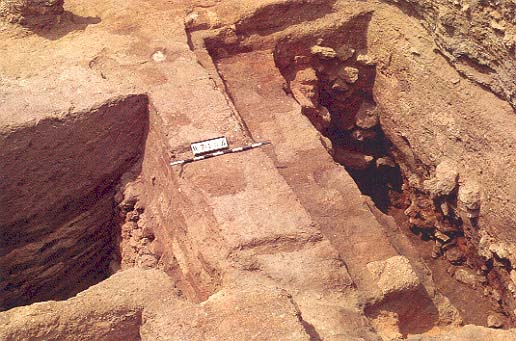
What is the evidence from Dor? The principal area where we have gotten down this far is in what we call area B1. From this period, in the tenth season, we found massive evidence of a fierce conflagration that had oxidized the mudbricks and shattered the limestone used in the buildings, leaving great areas of ash and charcoal as much as 6 feet thick. This destruction stratum was sealed at the bottom by floors on which we found pottery from the second half of the 11th century B.C.E. say about 1050 B.C.E. This was probably the remains of the Sikil city. Although only a limited area from this stratum has been excavated—a narrow strip about 30 feet long and 6 feet wide—this includes parts of two rooms separated by an extremely thick wall. The 028floor consists of a layer of plaster. The structure abuts the eastern city wall, which is large and strongly built. The city wall is composed of a base nearly 10 feet high, built of very large stones, and nearly that wide at the bottom, although narrower at the top. This stone base supported a stout wall made of flat, square mudbricks and preserved to a height of about two feet. A sand rampart was piled against the outer side of the wall to protect the foundations. This rampart was covered with a thick layer of clay to protect it from erosion and rain.
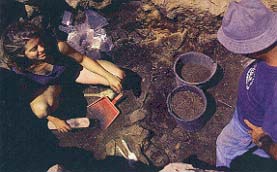
We initially dated this wall to the Middle Bronze Age II (1800–1550 B.C.E.) because of the Middle Bronze Age sherds we found in the rampart built against the wall and also because tremendous fortifications with ramparts like this (the so-called Hyksos rampart) were common in the Middle Bronze Age. However, we found 12th-century pottery all the way down to the bottom of the wall. We were forced to conclude that this entire massive fortification was built in the 12th century. It is the strongest fortification system from this period discovered in Palestine!
The same thick destruction layer resulting from a violent conflagration appeared on the other (western) side of the mound (our area F). Although we have not yet reached a clear floor level, this is enough to conclude that at this time (mid-12th to mid-11th centuries B.C.E.) the city extended over the entire mound and was violently destroyed. In our last season (1992), we also found the remains of the same fierce conflagration in the city center (our area G).
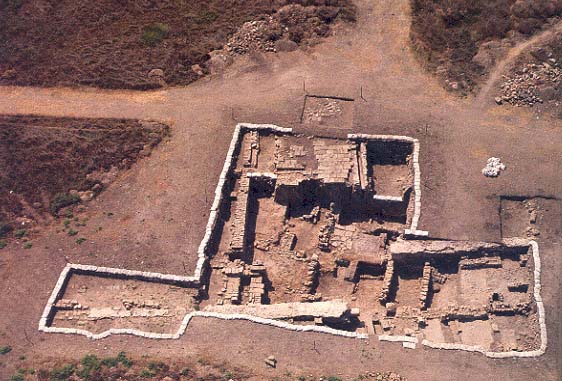
The burning question—if we may make a bad pun about a terrible disaster—is to whom did this large, fortified, and now-destroyed city belong? And by whom was it destroyed? Unfortunately, the archaeological evidence does not give us a clear answer. For example, we found a pithos (storage jar) decorated with wavy lines in relief; this form is known from the Upper Galilee, from the Syro-Palestinian coast and especially from Cyprus, but it may well have originated in the West. Could this be a Sikil vessel? Other vessels include a flask decorated with red concentric circles, several storage jars that continue the Canaanite storage-jar tradition and some small bowls. Although this pottery unquestionably dates this stratum to the second half of the 12th and first half of the 11th centuries B.C.E., it gives no clear indication of the identity of the builders of the city.
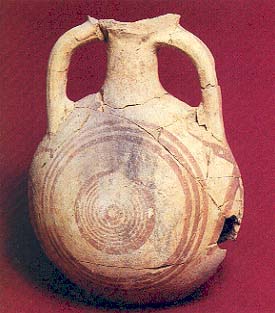
Other potsherds include Philistine bichrome ware and part of a rhyton (formal drinking cup) in the shape of a ram’s head. This was decorated with painted patters of a type found at Philistine sites such as Ashdod, Tell es-Sag (Gath), Tel Miqne (Ekron), Tell Qasile and Tell Jerishe on the banks of the Yarkon, as well as at two sites closer to Dor (Tel Zeror and Megiddo).
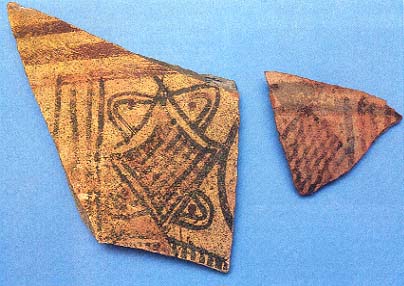
029
A final, somewhat more exotic find from this period was a bovine scapula (a cow’s shoulder blade) with incisions along its edges. Five similar scapulas have recently been discovered in a Philistine temple at Tel Miqne (Ekron). Many other examples are known from contemporaneous temples in Cyprus. The Ekron excavators suggest that their specimens were brought by the Philistines from Cyprus. The function of these scapulas is not clear. Some scholars think they formed part of a musical instrument, others more plausibly suggest that they were used in some kind of divination for foretelling the future.
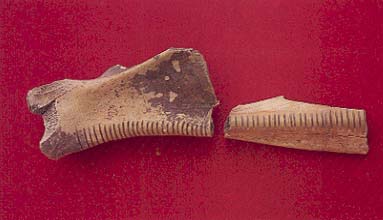
All this at the very least hints that Dor was a Sikil city. This conclusion is also supported by the literary evidence, especially “The Tale of Wen-Amon.” Although no certain conclusions can be reached at this time, it does appear that the city belonged to the Sikils and was destroyed by someone in about 1050 B.C.E. The Sikil city had been captured from the Canaanites about 150 years earlier. The Sikils, however, formed only a small part of the population. They therefore had less impact on the local culture of the city than was the case farther south, where the Philistine tribes settled in much larger numbers.
Our underwater colleague Avner Raban has investigated Dor’s harbors and their associated installations. Adjacent to the southern harbor, he discovered 030what he believes was a quay built by the Sikils when they controlled the city. The harbor installations at Dor, according to Raban, are the earliest in Palestine that can definitely be attributed to one of the Sea Peoples. Several of these installations resemble harbor installations at the Minoan site of Mallia in Crete and at Kition in Cyprus.
All this suggests a Sea People presence at Dor, although we cannot yet confidently distinguish between the material culture of the Philistines and that of the Sikils.
Who destroyed the Sea People city of Dor is also difficult to tell. The archaeological evidence suggests a date in the mid-11th century B.C.E., about 50 years before King David ascended to the throne. Whoever destroyed Dor was probably responsible for the contemporaneous destruction of a number of sites in the Acre valley and on the northern coast, such as Akhziv, Tell Keisan, Tell Abu Hawam, Megiddo, Yoqne‘am, and Tel Mikhal. In all of these sites, Phoenician material suddenly begins to appear in the mid-11th century B.C.E.
The principal Phoenician cities—Tyre, Sidon, Byblos and Arwad—never fell to the Sea Peoples. Indeed, this was the only area of Canaan, whose culture had flourished in the second millennium B.C.E., that remained unconquered. Undoubtedly many Canaanite refugees made their way here, and these cities experienced a rapid expansion and cultural growth. They soon began to spread their influence to adjacent regions, using the natural resources of the territory left to them—wood and harbors. This small Phoenician enclave in effect constituted a cultural island. As its population increased, its influence expanded—initially to the coast of Cyprus, where the first Phoenician colonies were apparently founded, then along the northern Palestinian coast, where a struggle for control of the marine trade routes ensued.
In my opinion, Dor was attacked and destroyed by the Phoenicians in the course of this struggle, as undoubtedly happened also at the Sea People city of Acre and at other coastal cities held by the tribe of the Sherden. In the coastal cities south of the Yarkon, where the Philistines held sway, the Phoenicians came 031in peace as traders.
After King David united the Israelite tribes in about 1000 B.C.E., he attacked the Philistines in the south. According to the Bible, he also captured the northern coast, including Dor, taking it from the Phoenicians who had wrested it from the Sea People tribe of Sikils. But either he or his son Solomon decided to withdraw from some of the coastal areas in the north in return for economic and commercial cooperation with the Phoenicians. This was, in short, a recognition of Phoenician cultural superiority in art, in building construction, and especially in shipbuilding, harbors and trade.
The destruction of the Sea People city of Dor as well as other contemporaneous cities in the area—and their rapid revitalization—were part of the Phoenician expansion. If, in the course of their expansion south, the Phoenicians had not come up against a united Israelite kingdom led by King David—which of course prevented their further expansion in this direction—they might not have turned so quickly to colonize the western Mediterranean. But they did—and they did as far west as Spain.
Phoenician culture soon became dominant at Dor and remained so for 800 years—even after the city was conquered by the Israelites and then by the Assyrians and then by the Babylonians. Formally it may not have been Phoenician after these conquests, but culturally it was.
In contrast to the Philistines, about whom we learn so much from the Bible, the Phoenicians are not even mentioned by name. We hear of them in some ancient royal inscriptions (principally of Assyrian kings) and from Greek sources, but the latter are mostly hostile: Beginning in about 650 B.C.E., Greeks and Phoenicians competed for over 500 years for control of the Mediterranean. The Phoenician sources themselves consist mostly of dedicatory inscriptions that contain no significant historical facts.
Another anomaly: For many years, most of the archaeological data on the Phoenicians came not from the Phoenician center (excavations at their four major cities—Arwad, Byblos, Sidon and Tyre—have not yielded much information because of changes in sea level and long sequences of occupation from antiquity to modern times), but from excavations outside of the Phoenician motherland.c Recently, important archaeological discoveries have been made at sites along the northern coastal strip of modern Israel, which forms the southern end of Phoenicia proper. Among these sites are Akhziv, Acre, Tell Keisan, Rosh Beth Zayit, Tell Abu Hawam and Shiqmona. But the most important site in this region is Tel Dor—the largest, most complete and best preserved Phoenician city yet excavated on the entire Phoenician coast. Aside from these excavations along the eastern rim of the Mediterranean, the richest and most beautiful Phoenician finds have been uncovered in Cyprus and in some Greek islands like Samos and Crete, in the Assyrian palaces at Nimrud and Khorsabad (as booty captured by the Assyrians) and in the western Phoenician colonies, such as Carthage, Motya (Sicily) and Tarsos (Sardinia).
Thus, from both the historical and the archaeological viewpoints, we are forced to rely on foreign sources and on excavations outside Phoenicia to learn about the Phoenicians!
The Phoenicians are of course important to students of the Bible. Here, too, the Phoenicians are special. They were the nearest people to the ancient Israelites in every respect. They spoke the same language, wrote in the same script and even practiced a very similar religion, at least in the First Temple period. They and the Israelites built Jerusalem together (Hiram helped Solomon build the Temple [1 Kings 5:1–18]), as well as several other cities, and went on joint trading expeditions (1 Kings 10:22). Their 076workshops functioned alongside each other. The clearest sign of their relationship is that they never went to war against each other—in sharp contrast to Israel’s relationships with all its other neighbors. Perhaps this was because the Phoenicians, in contrast to Israel’s other neighbors, possessed a high culture: They were the inheritors of Bronze Age Canaanites. Israel’s other neighbors, like Israel itself, were nomads of relatively modest cultures, especially their material culture.
The Phoenician culture was the mother culture of all the peoples of the Levant: the Arameans, the Israelites, the Judeans, the Philistines, the Ammonites, the Moabites and the Edomites. The Phoenicians excelled in almost everything they undertook. They were the best sailors (a Phoenician sailor named Scilax was the first to circumnavigate Africa), the best shipwrights and the most important merchants. It was they who brought the alphabet to their neighbors (including the Greeks). But most of all they excelled as craftsmen—builders, metalsmiths, and carvers of ivory, wood, shell and stone. They were also excellent sealmakers. They were famous for high-quality glass and superb textiles, some of which were dyed with the purple dye renowned throughout the ancient world (see Ezekiel 27).
It is this culture that we wanted most of all to explore at Dor.
The site of ancient Dor was securely identified only at the early part of this century. A doctoral student at Yale named George Dahl collected all the relevant ancient sources, from which he was able to establish that the mound known in Arabic as Khirbet el-Burj (the ruins of the fortress) was in fact ancient Dor. The identification has not been questioned since Dahl published his doctoral dissertation on the subject.
A few excavations explored Dor in the past. In 1923 and 1924, two seasons of excavation were carried out by the British archaeologist John Garstang. Unfortunately, almost nothing from this excavation was published, so it has been of little help to us. In the early 1950s, Joseph Leibovitch of the Israel Department of Antiquities exposed a Roman theater north of the mound and a large basilica southeast of the mound. Among the finds in the basilica was a Greek inscription that mentions a bishop named Akakios and an intriguing marble column with a small hole in it; around the hole are four crosses and a Greek inscription stating that the hole contained “a stone of Holy Golgotha.” As interesting as this is, it obviously comes from a much later time than the period on which we are focusing here.
I had my eye on Dor from the early 1970s. But the excavation of a major site like Dor required organization and funds far beyond my means. As a young archaeologist, I could only dream of such an expedition. There was another factor: At the time, Israeli archaeologists were just beginning to realize the importance of understanding any major site in terms of the region of which it was a part. For this reason, it was important to extend the investigation of a major site into an entire region, including smaller urban and rural settlements in the region. This approach required a largescale expedition even beyond that required for the tell itself.
I decided to carry out a regional investigation, but only in stages. I would begin by excavating a small settlement, as a kind of small-scale model excavation. Only later, perhaps in collaboration with others, would I go on to something bigger. For this smallscale excavation, I chose Tel Mevorakh, a small mound about seven miles south of Dor, on which I have already reported to BAR readers.d What I learned at Tel Mevorakh proved invaluable for understanding the structure and phases of the larger mound at Dor. It is often much easier to comprehend the morphology and stratigraphy of a “tiny” mound, subjected to a 078meticulous and “microscopic” examination, than a large site in which changes are much more gradual and where every phase contains so many details that it is easy to become distracted from the overall picture.
In 1976 I concluded the last season at Tel Mevorakh. At that time, Israel’s most illustrious archaeologist, Yigael Yadin, was planning to excavate Dor. I asked him if he would like to work together; if so, I would begin organizing the expedition. He agreed in principle, and we even printed a brochure to interest the collaboration of foreign institutions.
In the event, Yadin became involved in other matters that left him no time for our project. He entered politics, was elected to the Knesset, Israel’s parliament, and ultimately became deputy prime minister. Accordingly, I proceeded alone. Yadin died suddenly and unexpectedly in 1984. In the last two years of his life, he had returned to archaeology. Although he was never formally associated with the excavation at Dor, he visited us frequently and took a keen interest in what we were doing.
History runs deep at Tel Dor—45 feet deep to be exact! Layer upon layer of ancient cities, each built on the ruins of its predecessor, have formed this immense mound on Israel’s Mediterranean coast, about 12 miles south of Haifa. As extraordinary as the mound’s size is the large number of different people who have occupied or controlled the site. Following the Canaanites, who led Dor in a coalition of cities opposing Joshua (Joshua 11:1–15), the city experienced a series of conquests by Sikils—a Sea People tribe—Phoenicians, Israelites, Assyrians, Babylonians, and Persians. Despite this succession of conquests, the Phoenicians […]
You have already read your free article for this month. Please join the BAS Library or become an All Access member of BAS to gain full access to this article and so much more.
Already a library member? Log in here.
Institution user? Log in with your IP address or Username
Footnotes
B.C.E. (Before the Common Era), used by this author, is the alternate designation corresponding to B.C. often used in scholarly literature.
See
Important exceptions are the excavations at smaller sites, such as Ras Basit, Ras Ibn Hani, Teli Sukas and Sarepta (Biblical Zarephath).
See Ephraim Stern, “Excavations at Tell Mevorakh Are Prelude to Tell Dor Dig,” BAR 05:03.
Endnotes
The excavations at Tel Dor, directed by the writer, are sponsored by the Philip and Muriel Berman Center for Biblical Archaeology of the Institute of Archaeology of the Hebrew University of Jerusalem; the Israel Exploration Society; the University of California, Berkeley; California State University at Sacramento; South California College; Boston University; New York University; the University of Saskatchewan; and McMaster University at Hamilton, Ontario.
Yigael Yadin, “And Dan, Why Did He Remain in Ships?” Australian Journal of Biblical Archaeology 1 (1968), pp. 9–23; also see Lawrence E. Stager, “When Canaanites and Philistines Ruled Ashkelon,” BAR 17:02.


